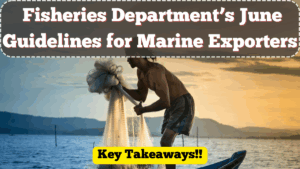The Indian Fisheries Department has released updated fisheries guidelines in June 2025 aimed at strengthening marine export compliance, quality control, and sustainable practices. These fresh directives are part of the government’s broader strategy to boost India’s global standing as a premier seafood exporter while safeguarding marine biodiversity.
The new fisheries guidelines cover everything from cold chain storage to traceability, vessel hygiene, catch reporting, and export documentation. These updates are now mandatory for all seafood exporters, aquaculture farms, and fishing vessels operating under the Marine Products Export Development Authority (MPEDA) jurisdiction.
For exporters, following these regulations is crucial to maintain global certifications, avoid shipment delays, and meet the expectations of importing countries.

Key Highlights of June 2025 Fisheries Guidelines
Here’s a quick overview of the most important changes issued under the June 2025 fisheries guidelines:
-
Digital Traceability Mandate: All marine products must now be traceable from source to export destination using QR-based digital systems.
-
Revised Cold Chain Norms: Updated temperature thresholds have been set for frozen, chilled, and live seafood to ensure zero contamination.
-
Mandatory Hygiene Inspections: Fishing boats and processing plants must undergo quarterly hygiene inspections, with certification by MPEDA.
-
No Export Without Catch Log Submission: Vessels must submit accurate electronic logs of catch quantity, species, and location.
-
Ban on Certain Species: Specific endangered species have been blacklisted from export to comply with international conservation treaties.
These fisheries guidelines are already being enforced, with random port inspections taking place across Kerala, Andhra Pradesh, Gujarat, and West Bengal.
Compliance Measures for Exporters and Stakeholders
Marine exporters, cold storage providers, and processors must now align their operations with the June 2025 fisheries guidelines. Here’s what is expected:
-
Install digital tracking systems for all export consignments.
-
Maintain cold storage logs and temperature alerts for every shipment.
-
Get all processing facilities certified for Good Hygiene Practices (GHP) and Hazard Analysis and Critical Control Points (HACCP).
-
Regularly train staff on cleaning protocols, equipment maintenance, and contamination checks.
-
Submit detailed species-wise catch reports on MPEDA’s new portal.
Failure to comply can result in license suspension, rejected consignments, and heavy penalties, especially when exporting to markets like the EU and USA.
Fisheries Guidelines Implementation Timeline
To assist stakeholders, the Fisheries Department has released an official implementation schedule:
| Area of Compliance | Deadline for Full Compliance | Responsible Party |
|---|---|---|
| Digital traceability system | 30 June 2025 | Exporters, Processors |
| Cold chain temperature audit | 15 July 2025 | Cold storage operators |
| Hygiene certification | 31 July 2025 | Fishing vessels & processors |
| Online catch reporting | 20 June 2025 | Vessel operators |
| Prohibited species enforcement | Immediate (effective June 1) | All exporters and fishing units |
The government has also launched an awareness campaign and training workshops in key seafood hubs.
Benefits of Following the New Guidelines
While these fisheries guidelines add responsibility, they bring long-term benefits:
-
Improved international trust and reputation for Indian marine exports.
-
Increased price realization due to higher quality and traceability.
-
Better access to premium markets such as Europe, Canada, and the Gulf.
-
Reduction in shipment rejections and contamination-related recalls.
These measures are also expected to boost India’s marine export value to over $9 billion by the end of 2025.
How Small Businesses Can Adapt
Small-scale fisheries and exporters need not worry. The Fisheries Department is offering:
-
Subsidies for software installation and traceability tools.
-
Free hygiene audit assistance for first-time applicants.
-
Access to a government-supported export facilitation cell to help with compliance.
Even micro and medium seafood businesses can now easily align with these new fisheries guidelines to ensure they remain part of India’s global supply chain.
FAQs
What are the new fisheries guidelines released in June 2025?
The June 2025 guidelines mandate digital traceability, cold chain temperature logs, catch reporting, and hygiene audits for all marine exporters and vessels.
Who must comply with these guidelines?
All seafood exporters, processors, aquaculture farms, cold storage providers, and fishing vessels are required to follow the updated rules.
What happens if exporters fail to follow these guidelines?
Non-compliance can lead to license suspension, rejected export batches, and monetary penalties.
How can small exporters get help with compliance?
The Fisheries Department is providing subsidies, training workshops, and free facilitation services for small and medium players.
Is there any financial support available?
Yes, the government is offering assistance for traceability system installation and hygiene certifications, especially for coastal SMEs.
Click here to know more.
